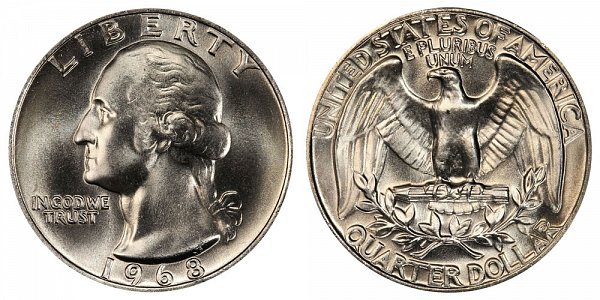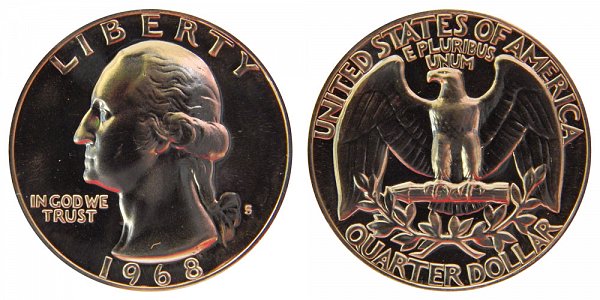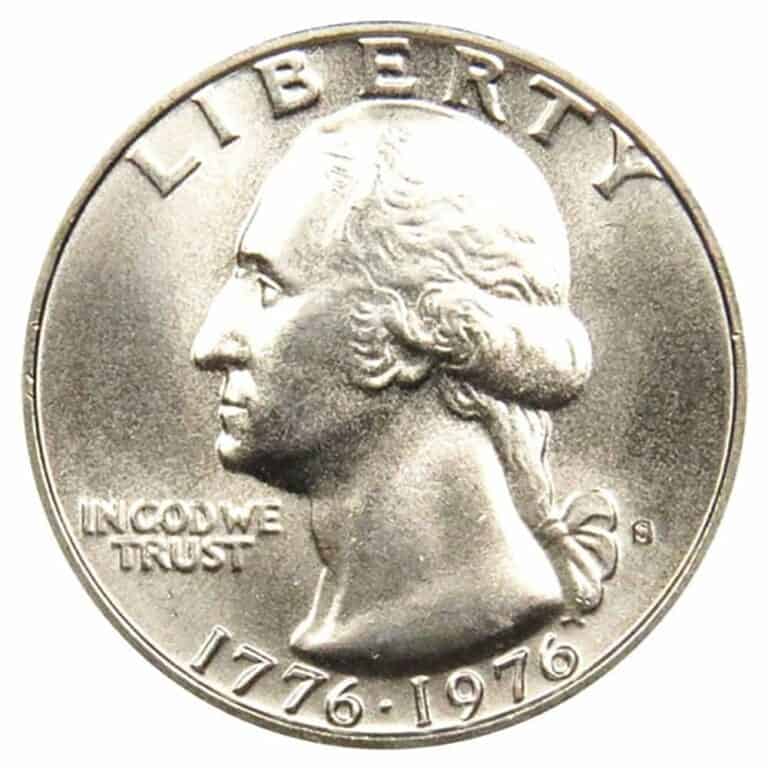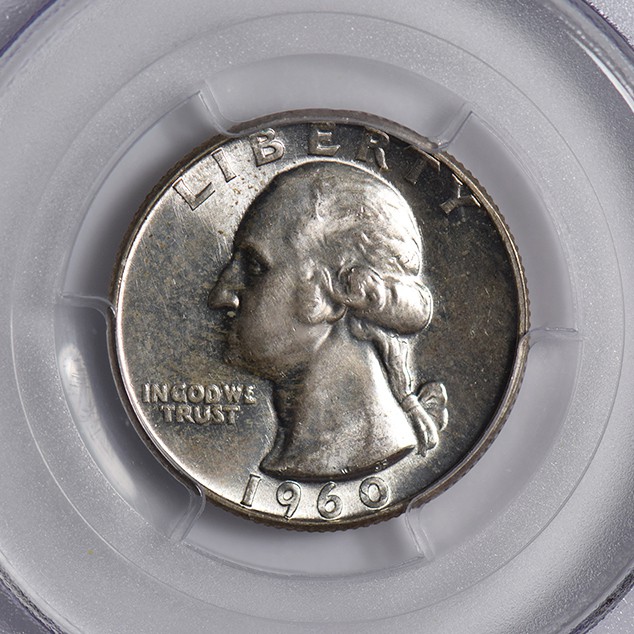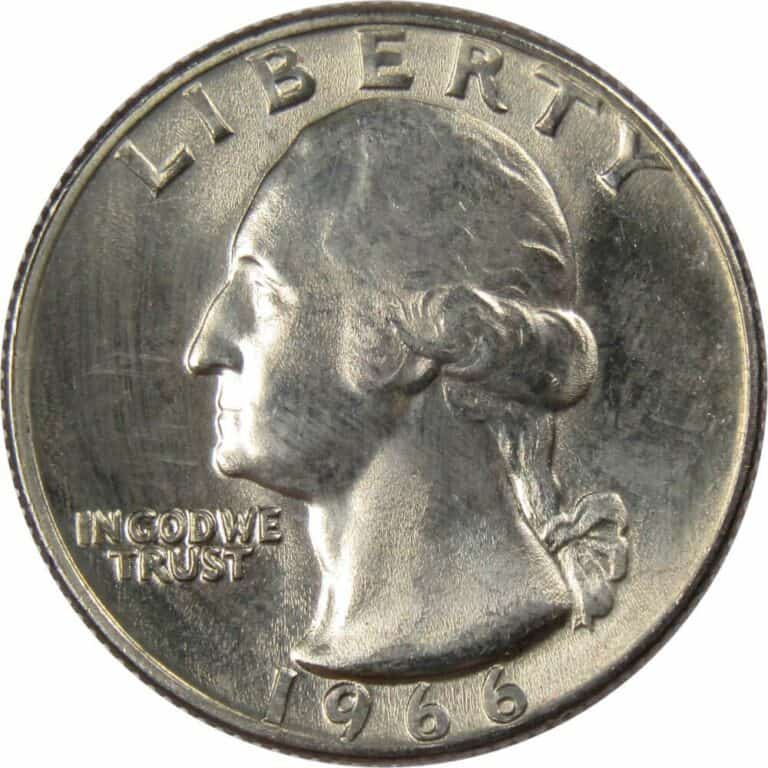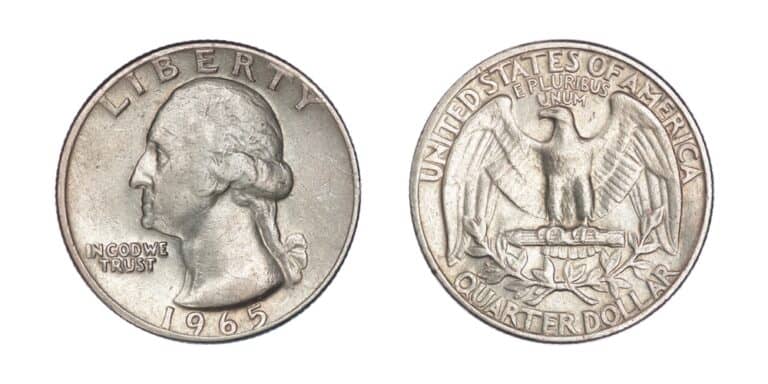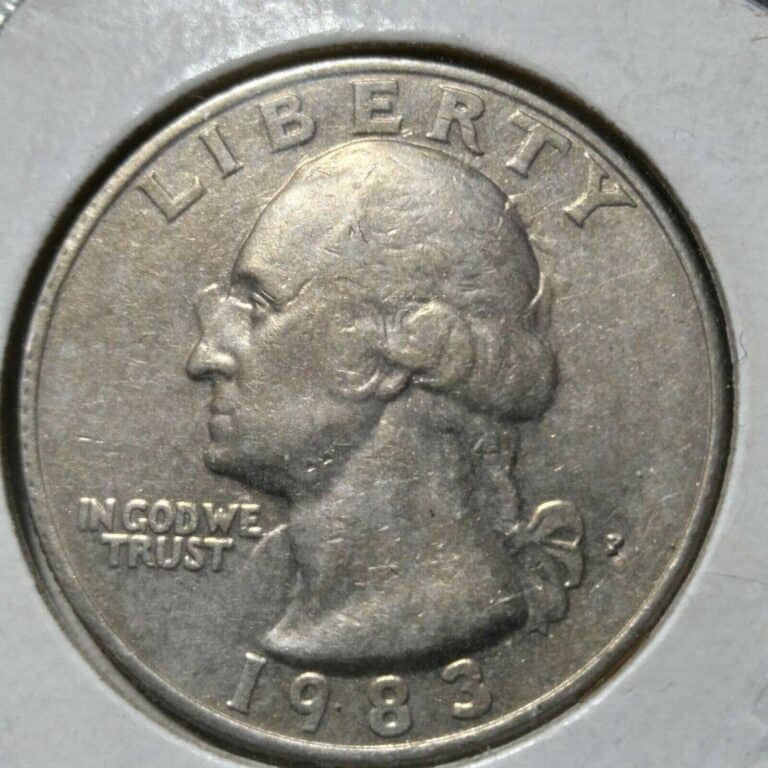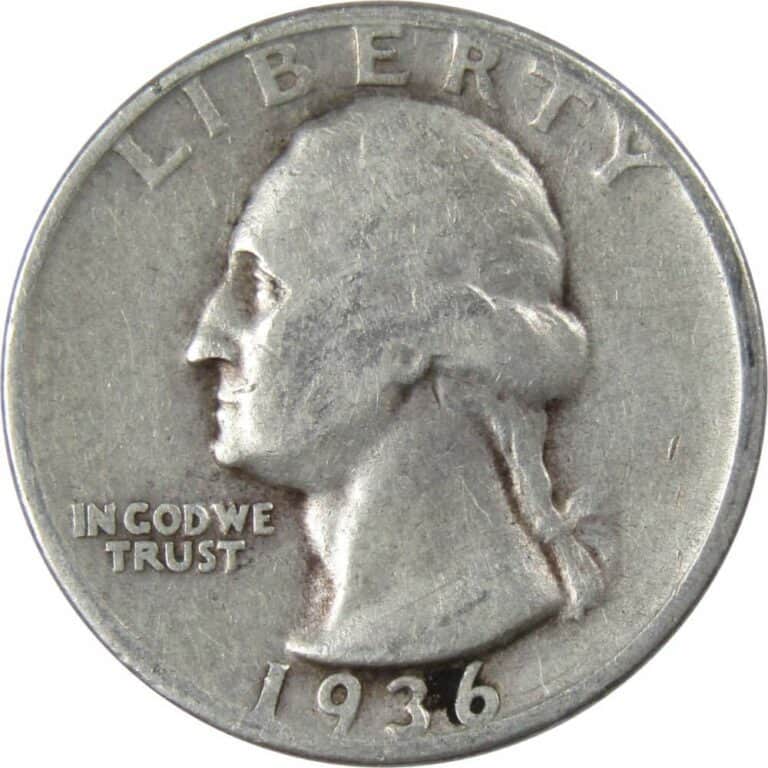1968 Quarter Value: How Much Is It Worth Today?

The Washington Quarter is famous as one of the longest-running coins in the US Mint’s history. This, naturally, means that there are a lot of these coins In circulation to this day, so, they aren’t exactly rare. On the other hand, that also means that there are lots of different variants and sub-variants of the Washington Quarter.
Here, we’ll talk about the 1968 quarter and what makes it special, what the different mintages of it are, how valuable it is, whether it’s worth it as a collector’s item, and more.
1968 Quarter Value Chart |
||||
| Mint mark | Good | Fine | Extremely Fine | Uncirculated |
| 1968 “D” Quarter Value | $0.25 | $0.25 to $1 | $1 to $4.80 | $12 to $1,560 and above |
| 1968 No Mint Mark Quarter Value | $0.25 | $0.25 to $1 | $1 to $7.20 | $20 to $2,000 and above |
| 1968 “S” Proof Quarter Value | n/a | n/a | $6 to $42 | $42 to $725 and above |
Given that the vast majority of 1968 quarter coins were released in wide circulation – and many are still in it – it’s not surprising that almost all of them are only worth their face value. Circulated coins garner wear and tear very quickly which drastically reduces their collector’s value.
This is truer for Washington quarters than for most other coins because of their design. While elegant and beautiful, the obverse design featuring Washington’s face is such that it’s very susceptible to wear and tear. So, even coins with Fine quality grades on the Sheldon coin grading scale are barely worth much above their face value.
This doesn’t mean that there aren’t valuable 1968 quarter coins, of course. Those pieces that have evaded being released in wide circulation can be worth many times their face value. In fact, near-perfectly preserved 1968 quarters can be valued in the dozens, hundreds, or even thousands of dollars based on their quality, mintage, and the presence of certain rare manufacturing errors.
1968 “D” Quarter Value
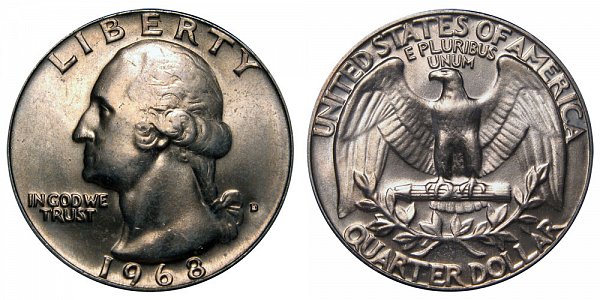
The first variant of the 1968 quarter we’ll talk about is the one made by the Denver Mint. In 1968, this mint made a total of 101,534,000 quarters which is fairly low by the standards of the Denver Mint but still a pretty high number overall. This means that 1968 quarter coins with the “D” mint mark can’t really be considered rare, even if they are fewer compared to other years.
As for the design of these coins, 1968 didn’t introduce any changes to the classic Denver-made Washington Quarter look. The clean and sleek but susceptible to wear obverse side of the coin features the left-facing head of George Washington with the word “Liberty” right above his head.
The phrase “In God we trust” is shown in a smaller font beneath Washington’s chin and the date – 1968, in this case – is at the bottom of the coin. The only other thing seen on the obverse side of a 1968 Denver-made quarter is the small “D” mint mark to the right of Washington, just above his shoulder.
The reverse side of the coin is much busier. Front and center is a large eagle with spread-out wings, perched on a bunch of arrows. Just below the arrows are a couple of olive branches and further below them – the coin’s denomination of “Quarter Dollar”.
Right above the eagle’s head is written the motto “E Pluribus Unum” which means “From many, one” and above that is written “United States of America.” The reverse side doesn’t have any mint marks or other features that show which US Mint it was made in or what year it was minted.
In essence, the design of the 1968 “D” quarter, while classic and beautiful, isn’t anything unique or note-worthy compared to the rest of the Washington Quarter series.
What’s more, like all other quarters minted after 1965, this coin isn’t made of silver either – instead, it’s made of a cupronickel clad (75% copper + 25% nickel alloy) over a fully copper core. This was made to prevent people from hoarding and melting the US currency for its silver and to lower the US Mint’s expenses.
That’s why older coppers tend to have a value of at least $5 or more even when they are in horrible physical condition, while a decent 1968 “D” quarter will only have its face value of $0.25.
All this tends to make these quarters relatively unremarkable but don’t let that fool you – as the value chart above shows, a Denver-made 1968 quarter can still be valued at dozens, hundreds, or even thousands of dollars.
All that matters is that 1) the coin hasn’t been released in wide circulation and is therefore well-preserved, and 2) that it has something unique about it, usually an interesting manufacturing error.
For example, 1968 “D” quarters of the highest possible quality – MS 68 and above where MS stands for “Mint State” and 68 is one of the top grades on the 1-to-70 scale – are often evaluated at $1,300 to $1,560 and above today. The most valuable 1968 “D” quarter to date was evaluated at $8,813 at a Heritage Auction in 2016.
1968 No Mint Mark Quarter Value
The second major variant of the 1968 quarter is the one with no mint mark. These are coins made by the Philadelphia Mint rather than in Denver. The reason why they don’t have a mint mark instead of having a “P” mint mark is just that was the standard practice of the Philly Mint for a long time – the lack of a mint mark was “the Philadelphia mint mark.”
This is often confusing to people new to numismatics as the missing mint mark seems like a rare and potentially valuable manufacturing error. That’s not at all the case, at least not in 1968 – a couple of decades later the Philadelphia Mint started putting a “P” mint mark on their coins after all.
In 1968, however, that mint produced a total of 220,731,500 quarters, none of which had mint marks, and almost all of them were released directly into wide circulation. Naturally, this makes those coins quite common and it also means that most of them have way more wear and tear accumulated over the years for them to be worth anything more than their face value of $0.25.
Just as with the “D” quarter, however, these 1968 no-mint-mark coins can also increase exponentially in value if they have been preserved in a near-mint state. In fact, Philadelphia-made 1968 coins tend to have slightly higher average prices than their Denver-made counterparts because they came out a bit better that year.
This is despite the fact that design-wise the coins from both mints are effectively identical. It’s also despite the Philadelphia Mint making about two times more quarters in 1968 – the higher number doesn’t translate in lower value as 99% of all coins made in either mint went into circulation anyway.
So, where a 1968 MS-quality quarter from Denver will usually cost somewhere between $12 and $1,560, a 1968 quarter of the same grade range made in Philadelphia will cost between $20 and $2,000 on average.
The highest-value quarter of the 1968 series also came from the Philadelphia Mint – it was sold at an auction in 2013 for $9,400.
1968 “S” Proof Quarter Value
Last but not least in the 1968 quarter series are the proof coins made by the San Francisco Mint. Or, rather, they are “least” in terms of value. This can appear a bit paradoxical as proof coins are, by their very nature, of much higher overall quality compared to regular coins.
Proof coins are made using entirely different minting and coating processes that both make them more expensive to make and give them a much greater detail and fidelity. Most coins you’ll see exhibited are proof coins. These are coins made both to serve as “proof” against counterfeits and to be sold to collectors for the Mint’s profit. In 1968, the San Francisco Mint made 3,041,506 such coins.
What’s more, these coins come in several sub-variants of their own:
- There are the “Deep Cameo” proof coins – these are the first fifty to a hundred coins to come out of the minting and coating process and they have the best possible detail.
- The next hundred or so coins are classified as “Cameo” quality – these coins are of a very slightly lower quality because the special proof-coin minting die has already been used for a bit, but they are still of great quality and look much better than regular coins.
- Last are the standard proof coins the mint produces – they are still of much higher fidelity than regular coins, just not quite as great as Cameo or Deep Cameo proofs.
So, if these 1968 proof coins made in San Francisco and bearing the “S” mint mark are of much better quality than regular 1968 quarters, why aren’t they more valuable?
While the lower mintage makes these coins rarer, but, on the other hand, as none of them get released in circulation, they end up being more numerous than their “regular” counterparts that have evaded being thrown into circulation.
So, it largely comes down to a numbers game – there are over three million 1968 proof quarters out there that are all of fantastic quality but there are only a handful of “D” and no-mint-mark 1968 quarters that are of such high quality. Standard scarcity/value dynamics ensure that the proof coins won’t be as valuable as their “regular” but still high-quality counterparts.
Still, there are 1968 proof quarters that can be worth thousands of dollars too. For example, a 1968 S PR 69 Deep Cameo Washington Quarter was sold for $2,875 in 2007.
The other exceptions are coins in the “Extremely Fine” quality grades – the several grades before 68 on the 1-to-70 grading scale. In those cases, a proof coin will be more valuable than a non-proof coin.
1968 Quarter Grading
As you can see from all of the above, 1968 quarter coins are graded just as any other coin – the higher the quality and the rarer the coin, the higher its value. Here’s a quick video for a visual example. The only other grading factor we’ve glossed over so far is the presence of certain rare manufacturing errors or details – those can drastically ramp up a coin’s value as they can make it much rarer.
Lists of 1968 Quarter Errors
There are many errors a coin can have, especially when the mintage has been significant enough. You can check out some examples here and we’ll list some of the most sought-after errors below:
1968 Quarter Off-Center Error
The off-center error is similar to the double die error. The difference is that, with an off-center error, the coin’s planchet has shifted before the very first strike of the minting die. So, both strikes have landed on the same spot on the coin’s planchet, but that spot is off-center.
1968 Proof Quarter Minted on a Silver Planchet Error
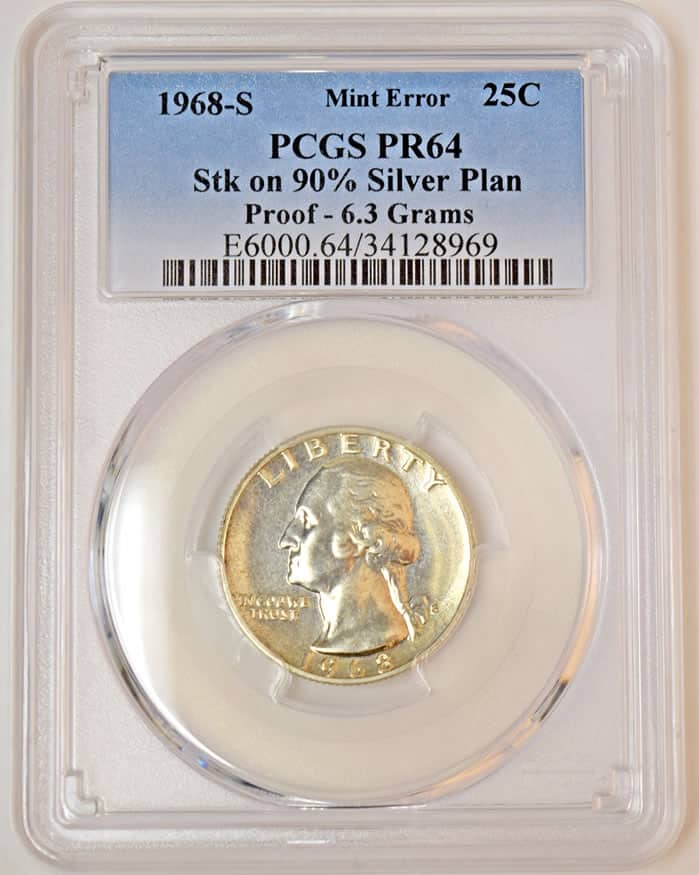
1968 quarters are meant to all be made of a copper and nickel alloy. There are a rare few proofs made in San Francisco that were accidentally minted on a silver coin planchet rather than a regular copper/nickel planchet.
1968 Quarter Double Die Error
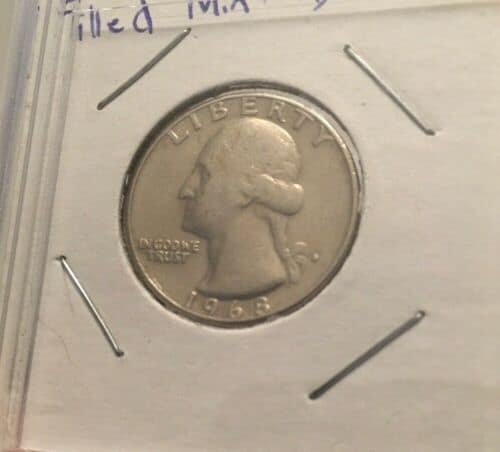
The double die error is quite well-known and desirable – it’s what happens when the coin’s planchet happens to shift slightly in between the two strikes of the minting die. In those cases, the design of the coin gets a bit distorted or blurry. If the distortion is minor enough to be visible and interesting but not so great to be ugly, it can increase the coin’s value quite a bit.
1968 Quarter FAQ
What makes a 1968 quarter rare?
As with any other coin, for a 1968 quarter to be considered rare, it needs to have been preserved in a near-mint state by someone, usually a collector, and it will also, ideally, have some type of unique manufacturing error such as a broad strike, off-center, or double die error.
Is a 1968 quarter all silver?
1968 quarters are made of nickel and copper, so, they aren’t supposed to have any silver in them. Earlier versions of the coin were made with 90% silver and 10% copper but that wasn’t the case in 1968.
